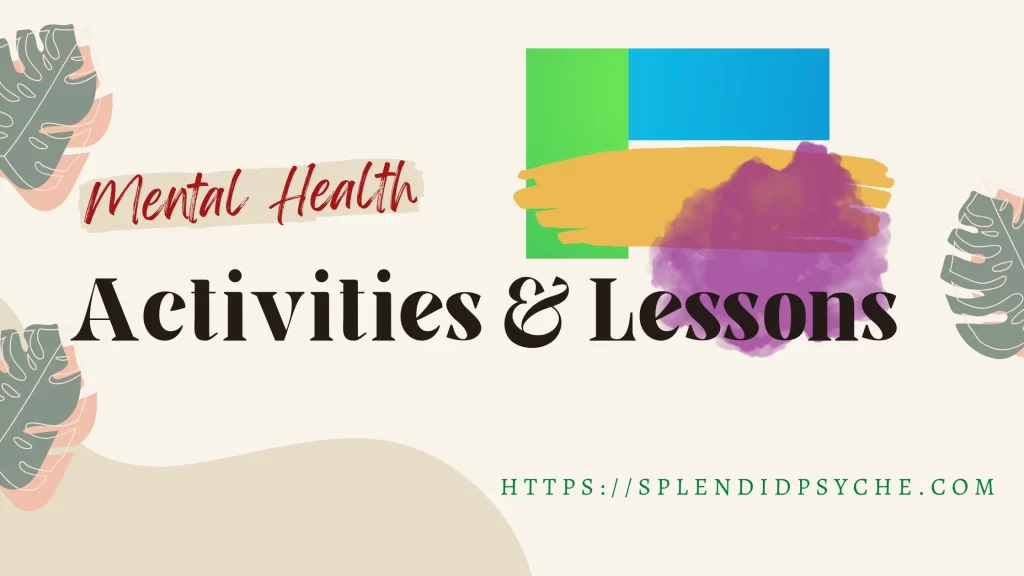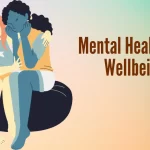Promoting Positive Mental Health Activities for Students
Mental health activities for students is a crucial aspect of overall well-being, especially for students navigating the challenges of academic life, social pressures, and personal growth. By incorporating mental health activities for students into the classroom or extracurricular programs, educators can foster a supportive environment that nurtures resilience, self-awareness, and emotional intelligence.
In this comprehensive guide, we’ll explore a variety of engaging mental health activities for students, designed to promote mindfulness, stress management, and a deeper understanding of mental well-being. Additionally, we’ll delve into mental health lessons that equip students with the knowledge and tools to cultivate a healthy mindset and navigate life’s challenges with confidence.

Mental Health Activities for Students
Mindfulness Exercises
Mindfulness practices encourage present-moment awareness and help students cultivate a sense of calm and focus. Here are some mindfulness activities for students:
- Breathing Exercises: Guide students through simple breathing techniques, such as belly breathing or box breathing, to reduce anxiety and promote relaxation.
- Body Scans: Lead students through a guided body scan, where they tune into physical sensations and release tension.
- Mindful Listening: Play calming music or nature sounds, and encourage students to focus on the present moment without judgment.
Gratitude Journaling
Cultivating gratitude can significantly improve mental well-being by shifting focus towards the positive aspects of life. Encourage students to keep a gratitude journal, where they can record daily entries of things they’re thankful for, no matter how small.
Emotional Check-Ins
Create a safe space for students to share their feelings and emotions without fear of judgment. Use creative prompts, such as emotion wheels or emotion cards, to help them identify and communicate their emotional states.
Self-Care Activities
Self-care is essential for maintaining mental health. Introduce students to various self-care activities they can incorporate into their daily routines, such as:
- Relaxation Techniques: Teach progressive muscle relaxation, visualization, or guided imagery exercises.
- Creative Expression: Encourage students to explore art, writing, or music as outlets for self-expression and stress relief.
- Physical Activities: Incorporate gentle yoga, stretching, or dance breaks into the classroom routine.
Positive Affirmations
Positive affirmations can boost self-esteem and foster a growth mindset. Encourage students to create personalized affirmations or provide them with a list of empowering statements to repeat daily.
Mental Health Lessons for Students
Understanding Mental Health
Educate students about the fundamentals of mental health, including the different types of mental health conditions, their causes, and the importance of seeking professional help when needed.
Stress Management
Teach students effective stress management techniques, such as time management strategies, relaxation methods, and healthy coping mechanisms. Discuss the impact of stress on mental and physical well-being, and provide practical tips for identifying and managing stress triggers.
Emotional Intelligence
Emotional intelligence is a crucial skill for navigating interpersonal relationships and managing emotions effectively. Provide lessons on identifying and understanding emotions, developing empathy, and practicing effective communication and conflict resolution strategies.
Resilience Building
Resilience is the ability to bounce back from adversity and cope with life’s challenges. Offer lessons on developing a growth mindset, cultivating self-compassion, and building resilience through goal-setting, problem-solving, and positive self-talk.
Healthy Relationships
Explore the characteristics of healthy relationships, including communication, boundaries, and respect. Discuss the impact of unhealthy relationships on mental health and provide resources for seeking support in cases of abuse or toxic dynamics.
Stigma and Mental Health Awareness
Reduce the stigma associated with mental illness and raise public awareness of it. Encourage open discussions and provide accurate information to dispel myths and misconceptions.
Implementing Mental Health Activities and Lessons
When incorporating mental health activities for students and lessons into your curriculum or program, consider the following tips:
Create a Safe and Supportive Environment
Establish a non-judgmental and inclusive space where students feel comfortable sharing their thoughts and experiences without fear of ridicule or discrimination.
Tailor Activities and Lessons to Different Age Groups
Adapt the activities and lessons to suit the developmental stages and interests of your students. Younger students may benefit from more interactive and creative approaches, while older students may prefer discussions and self-reflective exercises.
Involve Parents and Caregivers
Engage parents and caregivers in the process by providing them with resources and information about the mental health activities and lessons you’re implementing. Encourage open communication and collaboration to support students’ mental well-being both at school and at home.
Collaborate with Mental Health Professionals
Consider partnering with mental health professionals, such as school counselors, therapists, or psychologists, to ensure the accuracy and appropriateness of the information and activities you’re providing. They can also offer valuable insights and guidance.
Foster Ongoing Reflection and Discussion
Encourage students to reflect on their experiences with the mental health activities and lessons, and create opportunities for open discussions and sharing. This can promote a deeper understanding and normalize conversations around mental health.
Provide Additional Resources and Support
Offer students and their families access to additional resources, such as helplines, mental health organizations, or recommended reading materials, to further support their mental well-being journey.
By incorporating mental health activities for students and mental health lessons into your educational setting, you can create a supportive and nurturing environment that promotes emotional well-being, resilience, and a deeper understanding of mental health. Remember, prioritizing mental health is not only beneficial for students’ academic performance but also for their overall quality of life and future success.
Frequently Asked Questions
What are healthy activities for mental health?
Engaging in healthy activities that promote mental well-being is crucial for maintaining a balanced and fulfilling life. Here are some examples of healthy activities for mental health:
- Exercise: Regular physical activity, such as walking, running, cycling, or practicing yoga, can boost mood, reduce stress, and improve overall mental health.
- Mindfulness and meditation: Practices like deep breathing exercises, body scans, and guided meditations can help cultivate present-moment awareness, reduce anxiety, and promote relaxation.
- Creative expression: Activities like writing, painting, dancing, or playing music can serve as therapeutic outlets for processing emotions and relieving stress.
- Spending time in nature: Being outdoors and connecting with nature can have a calming effect and improve overall well-being.
- Socializing and building connections: Maintaining healthy relationships and engaging in social activities can provide a sense of belonging and support, which are essential for mental health.
- Practicing gratitude: Keeping a gratitude journal or regularly reflecting on the things you’re thankful for can cultivate a more positive mindset.
- Engaging in hobbies and leisure activities: Pursuing enjoyable hobbies, such as reading, gardening, or playing sports, can provide a sense of purpose and fulfillment.
What are 5 ways to improve mental health?
Here are five effective ways to improve mental health:
- Develop a self-care routine: Prioritize activities that promote relaxation, stress management, and overall well-being, such as exercise, meditation, or engaging in hobbies you enjoy.
- Build a strong support system: Surround yourself with positive, supportive people who understand and validate your experiences. If necessary, look for counselling or support groups.
- Practice mindfulness and stress management techniques: Incorporate mindfulness practices like deep breathing, meditation, or yoga into your daily routine to help manage stress and cultivate present-moment awareness.
- Maintain a balanced lifestyle: Prioritize healthy habits like regular exercise, a nutritious diet, adequate sleep, and leisure time to promote overall well-being.
- Challenge negative thought patterns: Identify and challenge negative or irrational thought patterns that may contribute to poor mental health. Cognitive-behavioral techniques, such as reframing or gratitude journaling, can help shift your mindset.
What to do for mental health day at school?
Mental health day at school can be a great opportunity to raise awareness, educate students, and promote positive mental well-being. Here are some activities you can organize:
- Invite a mental health professional or counselor to give a presentation or lead a workshop on topics like stress management, self-care, or identifying and coping with mental health challenges.
- Host a mindfulness or yoga session to introduce students to relaxation techniques and promote present-moment awareness.
- Organize a mental health fair or resource fair, where different organizations or mental health professionals can set up booths and provide information and resources.
- Encourage students to create and display artwork, poetry, or other creative expressions related to mental health themes.
- Hold a movie screening or book discussion focused on mental health-related topics to encourage open conversations.
- Organize a mental health walk or fundraiser to raise awareness and support mental health initiatives in your community.
- Provide students with self-care kits or resources, such as stress balls, mindfulness apps, or lists of helplines and support services.
What are mental health activities for children?
Mental health activities for children should be age-appropriate, engaging, and designed to promote emotional intelligence, self-awareness, and resilience. Here are some examples:
- Emotion charades or emotion identification games: Help children recognize and name different emotions.
- Mindfulness stories or guided imagery: Encourage relaxation, present-moment awareness, and imagination through storytelling.
- Crafting or coloring: Creative activities can serve as therapeutic outlets for expression and stress relief.
- Movement and dance: Physical activity and creative movement can boost mood and promote self-expression.
- Deep breathing exercises or yoga poses: Introduce simple mindfulness practices to help children manage stress and anxiety.
- Gratitude exercises or journaling: Foster a positive mindset by encouraging children to reflect on things they’re thankful for.
- Role-playing or social skills activities: Help children develop empathy, communication skills, and healthy relationships.
What activities are good for kids with depression?
Children with depression may benefit from activities that promote self-expression, relaxation, and positive engagement. Here are some recommended activities:
- Art therapy: Engaging in creative arts like drawing, painting, or sculpting can provide a healthy outlet for emotions and self-expression.
- Music therapy: Playing or listening to music can be therapeutic and mood-boosting for children with depression.
- Journaling or writing: Encouraging children to write about their thoughts and feelings can help them process emotions and gain self-awareness.
- Mindfulness and relaxation exercises: Deep breathing, meditation, or guided imagery can help reduce anxiety and promote calm.
- Physical activity: Exercise, such as walking, swimming, or playing sports, can improve mood and alleviate depressive symptoms.
- Social activities: Engaging in group activities, games, or outings with peers can foster connections and combat social isolation.
- Cognitive-behavioral therapy (CBT) techniques: Activities that challenge negative thought patterns and promote more positive thinking can be beneficial.
What are the three kinds of mental activities?
The three main types of mental activities are:
- Cognitive activities: These involve processes related to thinking, reasoning, problem-solving, memory, attention, and perception. Examples include puzzles, brain teasers, memory games, and learning new skills or information.
- Emotional activities: These activities focus on understanding, expressing, and regulating emotions. They may involve practices like journaling, art therapy, mindfulness exercises, or role-playing scenarios to develop emotional intelligence and self-awareness.
- Social activities: These activities involve interacting with others and building interpersonal skills. Examples include group discussions, team-building exercises, conflict resolution activities, and activities that promote communication and empathy.
It’s important to engage in a balanced combination of cognitive, emotional, and social activities to promote overall mental well-being and personal growth.



